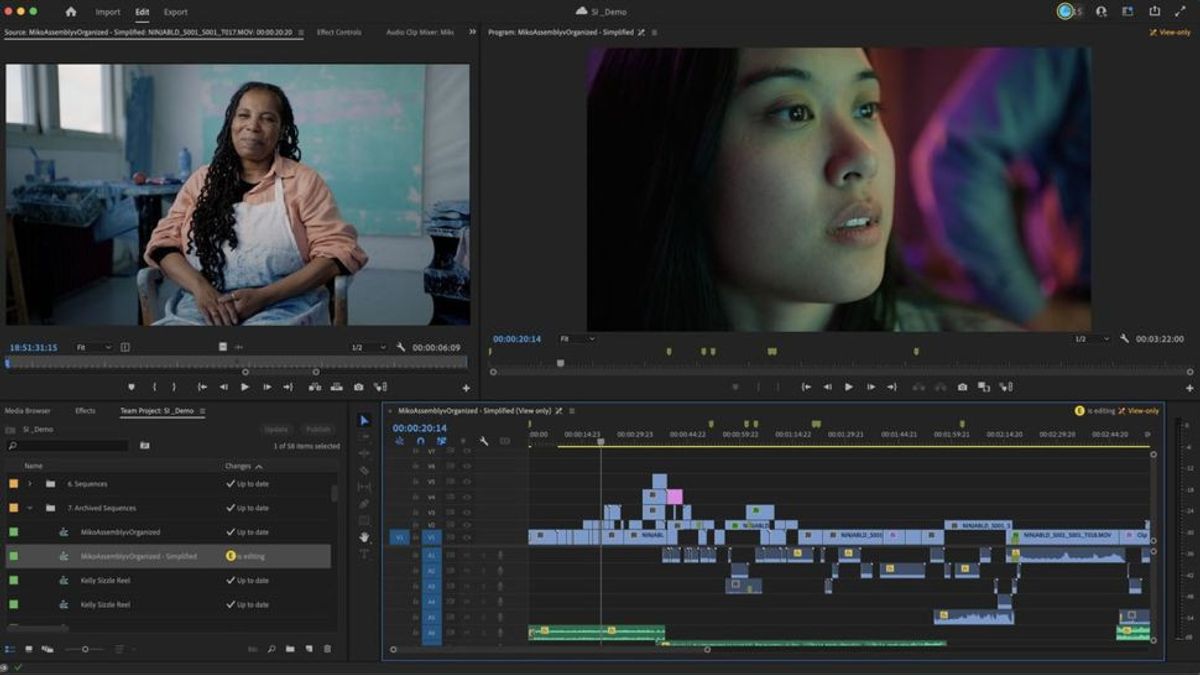JAKARTA - Adobe at the 2023 Nation Association of Broadcasters (NAB) Show revealed several updates that came to After Effects, Frame.io, and Premiere Pro this year.
The company added text-based video editing features to the Premiere Pro and the expansion of the cloud-based video collaboration platform Frame.io to include photos and PDFs. Meanwhile, After Effects presents a panel to make the design move faster.
Text-Based editing feature in the Premiere Pro changed the rough workflow and opened up new ways to work quickly with videos. Supported by Adobe Sensei, Text-Based Editing is equipped with the latest Artificial Intelligence (AI) to automatically copy the source media.
Instead of watching the footage for hours just to find the right sound cut, now users can read transcripts at first glance, search for keywords, and add them to Timeline for editing.
The Premiere Pro generates transcripts for sequences when the user creates them. So, once the user has multiple clips on Timeline, they can copy and paste the phrases in the transcript sequence and see edited results on Timeline automatically change to match them.
Text-Based Editing is like having a piece of paper from a transcript. And, when editing is complete, Text-Based Editing will give users a ready-to-use transcript that can be used to quickly create text.
Adobe completed the acquisition of Frame.io in 2021, and since then, Adobe has been working to improve the video collaboration platform for its users. Frame.io now has a new feature called Forensic Watermarking.
Forensic Watermarking is an invisible water signature, not detected by the human eye embedded in the video. This signature can survive file copying, screen recording, or even external recording of the camera and mobile device.
In fact, the water sign can be made in seconds and applied to the clip for a short of 30 seconds. That way, users' work will always be marked as their own, even if someone steals it and markets it as their own.
When someone uses their work, users can contact the Frame.io support representative, which can then extract the invisible water signature from the video (if any) and get information about who is entitled to the record.
In addition, Frame.io can also create photos and PDFs. The update is designed to enhance cross-department long-distance collaboration, attract more creative and business professionals by introducing new end-to-end workflows to capture, edit, review, and approve content through one centralized hub.
Frame.io users can share and review written material such as scripts or press releases with video assets or related photography in real time as projects develop. Like the support of the existing Frame.io video, PDF files and photos (including annotations) can be accessed and edited on iPhone, iPad, and web.
Thanks to the integration of Frame.io Cameras to the new Cloud, photographers can directly transfer RAW, JPEG, and HEIF files from their cameras to cloud platforms where images can be reviewed by the editor, reducing the need to transfer files physically from card memory and hard drive.
Modeled on similar panels in Adobe Illustrator and Adobe Photoshop, the new Properties panel in After Effects makes the design move faster. Instead of browsing the layer to make adjustments, controls are presented to users contextually, just next to the composition window.
The Property Panel also functions with Essential Property, saving more time when users need to create several versions of the same type of graph.
After Effects now also offers genuine support for ACES and OpenColorIO. ACES is a color exchange standard with a very wide color gamut, for a more dynamic range and richer image details.
And if users work with artists or other facilities, ACES and OpenColorIO color management makes it easier to ensure consistent color when handing over assets.
It should be noted that Text-Based editing, a new feature of Frame.io, and After Effects is currently still in beta but is expected to be delivered in May, as quoted from the Adobe page, Friday, April 14.
The English, Chinese, Japanese, Arabic, and French versions are automatically generated by the AI. So there may still be inaccuracies in translating, please always see Indonesian as our main language. (system supported by DigitalSiber.id)












